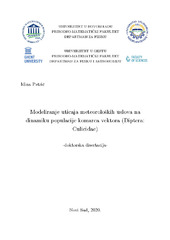Prikaz osnovnih podataka o disertaciji
Modelling the influence of meteorological conditions on mosquito vector population dynamics (Diptera, Culicidae)
Modeliranje uticaja meteoroloških uslova na dinamiku populacije komarca vektora (Diptera: Culicidae)
| dc.contributor.advisor | Lalić, Branislava | |
| dc.contributor.advisor | Pavkov-Hrvojević, Milica | |
| dc.contributor.advisor | Termonia, Piet | |
| dc.contributor.advisor | Van Schaeybroeck, Bert | |
| dc.contributor.other | Djurdjevic, Vladimir | |
| dc.contributor.other | Balaž, Igor | |
| dc.contributor.other | Hamdi, Rafiq | |
| dc.contributor.other | Hendrickx, Guy | |
| dc.creator | Petrić, Mina | |
| dc.date.accessioned | 2020-11-02T10:46:55Z | |
| dc.date.available | 2020-11-02T10:46:55Z | |
| dc.date.issued | 2020-10-16 | |
| dc.identifier.uri | https://www.cris.uns.ac.rs/DownloadFileServlet/Disertacija159239172767224.pdf?controlNumber=(BISIS)114757&fileName=159239172767224.pdf&id=15821&source=NaRDuS&language=sr | sr |
| dc.identifier.uri | https://www.cris.uns.ac.rs/record.jsf?recordId=114757&source=NaRDuS&language=sr | sr |
| dc.identifier.uri | https://www.cris.uns.ac.rs/DownloadFileServlet/IzvestajKomisije159239174166268.pdf?controlNumber=(BISIS)114757&fileName=159239174166268.pdf&id=15822&source=NaRDuS&language=sr | sr |
| dc.identifier.uri | /DownloadFileServlet/IzvestajKomisije159239174166268.pdf?controlNumber=(BISIS)114757&fileName=159239174166268.pdf&id=15822 | |
| dc.identifier.uri | https://nardus.mpn.gov.rs/handle/123456789/17569 | |
| dc.description.abstract | Meteorological conditions have a significant influence on the time of occurrence, abundance and activity of the mosquito vector. In the current context of climate change, it is of great importance to assess the impact of shifts in climatic conditions on the suitability for the establishment and annual activity of the vector species. Moreover, changes in the variability of meteorological elements and their extremes can generate unexpected changes in the mosquito vector population which in turn have an important effect on human health. One of the ways to put these causes and effects into perspective is to simulate the activity of the vector within a processbased framework which allows for the analysis of the contribution of individual factors on the different life stages of the vector. Such analysis is presented by use of sophisticated dynamical models simulating the characteristics of the biological population, forced by observed meteorological data, capturing the localmicro-environment of the vector habitat, and validated by the observed entomology.Numerical models are being developed to model vector population dynamics and the expected circulation of the virus within a closed system. Two modelling approaches are standardly applied to modelling vector population dynamics: Mechanistic and Stochastic. The advantage of mechanistic over statistical models is that they can provide a deterministic framework allowing for the isolated evaluation of each input parameter and their effect on the modelled system. Mechanistic dynamical models are used to describe the biophysical processes or part of the process as a response to changes in the meteorological conditions. The work carried out in this thesis can be summarized as follows: (i) Analysis of the association between the most important abiotic drivers influencing the population dynamics, annual activity and time of occurrence of Culex pipiens and Aedes aegypti; (ii) Identifying the most important climatic factors and model settings as a function of climatic characteristics of the study region; (iii) Modelling the vector population dynamics and stability analysis of the dynamical system (iv) Analysis of different verification techniques and implications in terms of model application; (v) Feasibility analysis of improving the model with a Land-Surface Parametrization scheme and short-range forecasting of pest population dynamics. | en |
| dc.description.abstract | Meteorološki uslovi bitno utiču na vreme pojave, brojnost vektora i njihovu aktivnost. U uslovima evidentnih promene klime, od ogromne je važnosti sagledati uticaj očekivanih promena klime na pogodnost uslova na pojavu izabranih vektora. Takodje, značajne promene kolebanja meteoroloških elemenata u odnosu na višegodišnji prosek i sve češće pojave nepovoljnih vremenskih prilika dovode do neočekivanog ponašanja populacije komarca što značajno utiče na kvalitet života i zdravlje ljudi. Jedini način da se sagledaju uzroci i posledice navedenih pojava zasniva se na simulaciji aktivnosti i brojnosti vektora uz mogućnost testiranja uticaja svakog pojedinačnog faktora. Ovu mogućnost pružaju samo visoko sofistikovani dinamički modeli koju su prošli proces kalibracije i validacije zasnovan na izmerenim vrednostima meteoroloških elemenata i karakteristika biološke populacije. Sofistikovani modeli za simulaciju dinamike populacije vektora i očekivane cirkulacije vektorskih transmisivnih bolesti se koriste sa ciljem modeliranja potencijalnog rizika od zaraze i epidemije. Modeli zasimulaciju dinamike vektora mogu da se podele na dve glavne grupe: Mehanističke i Statističke. Prednost mehanističkih modela nad statističkim je što mogu da se koriste za evaluaciju uticaja izolovanog faktora na dinamički sistem i odgovarajuće promene brojnosti unutar svake faze u razvoju vektora. Mehanistički dinamički sistemi se koriste kako bi se opisao mehanizam biofizičkog procesa ili dela procesa u zavisnosti od forsirajuće veličine. Predmet istraživanja u ovom radu jeste identifikovanje najznačajnijih bioloških i fizičkih procesa kao i odgovarajućih faktora koji utiču na brojnost i aktivnost vektora roda Aedes i Culex. Ciljevi istraživanja mogu da se sumiraju na sledeći način: (i) analiza najznačajnijih meteoroloških parametara koji utiču na vreme pojave, brojnost i aktivnost vektora Aedes i Culex roda; (ii) definisanje najznačajnijih klimatskih faktora i stepena osetljivosti procesa na njih; (iii) modeliranje dinamike populacije vektora i analiza stabilnosti dinamičkog sistema; (iv) verifikacija i analiza metoda verifikacije i validacije dinamičkog modela; (v) kratkoročna prognoza dinamike populacije komarca i formulacija hidrološkog modula upotrebom SURFEX površinske šeme sa ECOCLIMAP fiziogeografskim podacima. | sr |
| dc.description.abstract | sr | |
| dc.language | en | |
| dc.publisher | Универзитет у Новом Саду, Природно-математички факултет | sr |
| dc.rights | openAccess | en |
| dc.rights.uri | https://creativecommons.org/licenses/by-nc/4.0/ | |
| dc.source | Универзитет у Новом Саду | sr |
| dc.subject | Vector population dynamics modelling | en |
| dc.subject | Modeliranje dinamike populacije vektora | sr |
| dc.subject | Aedes aegypti | en |
| dc.subject | Culex pipiens | en |
| dc.subject | Aedes aegypti | sr |
| dc.subject | Culex pipiens | sr |
| dc.title | Modelling the influence of meteorological conditions on mosquito vector population dynamics (Diptera, Culicidae) | en |
| dc.title.alternative | Modeliranje uticaja meteoroloških uslova na dinamiku populacije komarca vektora (Diptera: Culicidae) | sr |
| dc.type | doctoralThesis | en |
| dc.rights.license | BY-NC | |
| dcterms.abstract | Павков-Хрвојевић Милица; Лалић Бранислава; Термониа Пиет; Ван Сцхаеyброецк Берт; Дјурдјевиц Владимир; Хендрицкx Гуy; Хамди Рафиq; Балаж Игор; Петрић Мина; | |
| dc.identifier.fulltext | http://nardus.mpn.gov.rs/bitstream/id/153533/Disertacija.pdf | |
| dc.identifier.rcub | https://hdl.handle.net/21.15107/rcub_nardus_17569 |


